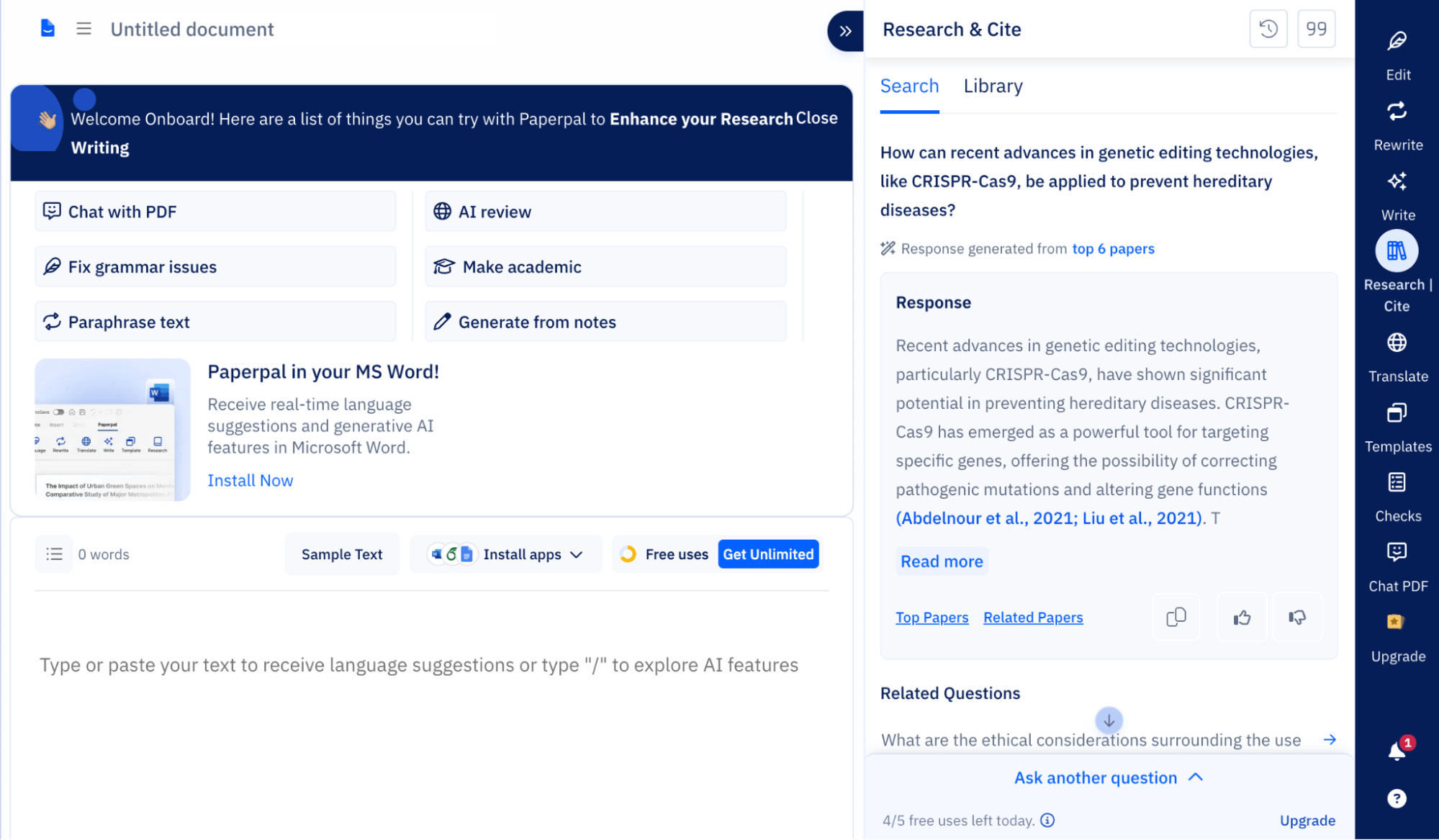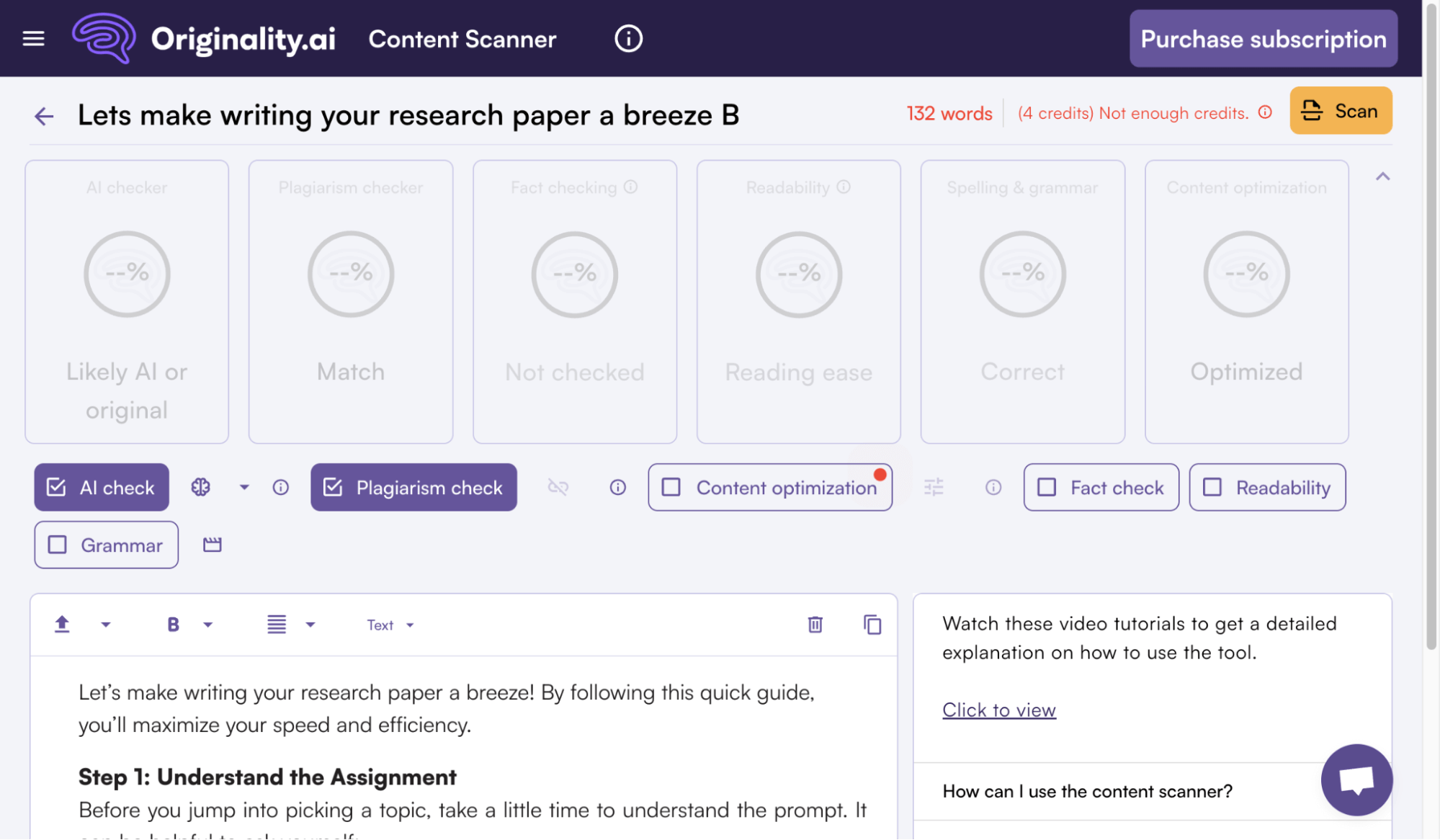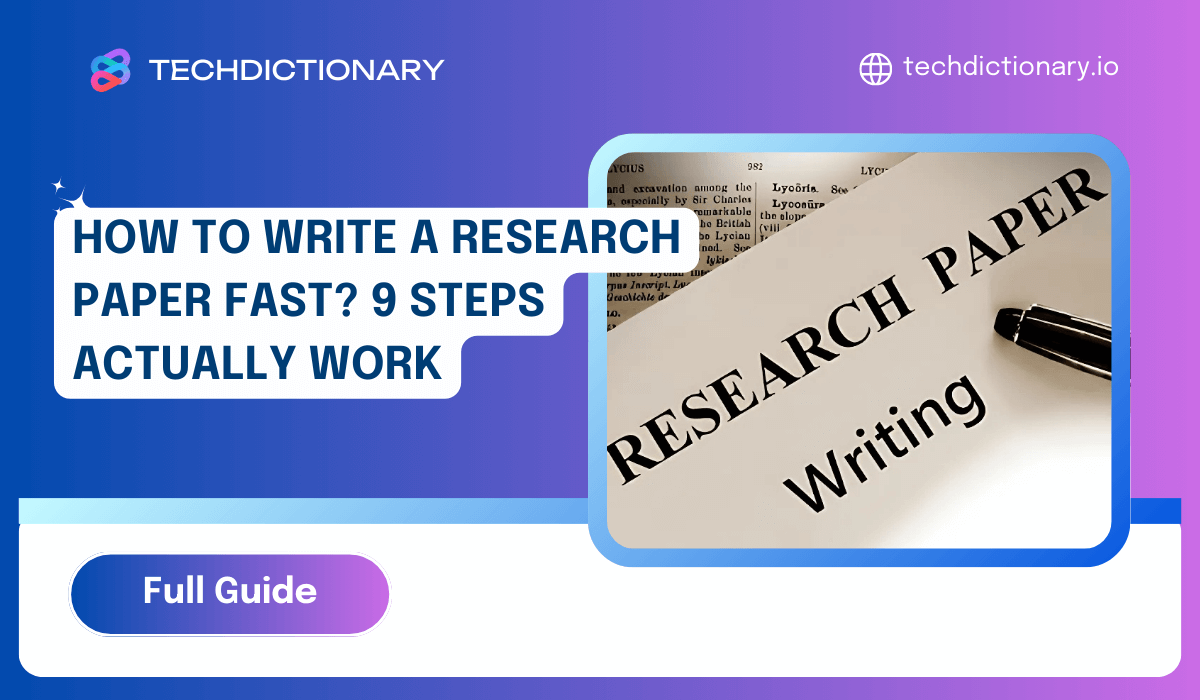Heads up! The article includes affiliate links. If you click and purchase, we may receive an affiliate commission at no extra cost to you. Check our Affiliate Disclaimer.
Hey there! We all know how stressful deadlines for research papers can be. Whether you’re behind or just lost track of time, the pressure is on! But don’t worry—we’re here to help you figure out how to write a research paper fast.
Instead of a dry list of tips, we’ll offer a friendly, step-by-step approach from TechDictionary, based on real insights.
We’ll share 9 actionable steps, show you how to leverage AI, and provide some techniques to streamline your process. You’ll create a solid paper even under tight deadlines.
Let’s get started!
How to Write a Research Paper Fast in 9 Steps?
Let’s make writing your research paper a breeze! By following this quick guide, you’ll maximize your speed and efficiency.
Step 1: Understand the Assignment
Before you jump into picking a topic, take a little time to understand the prompt. It can be helpful to ask yourself:
- “What’s the core task?”
- “What’s the deadline?”
- “What’s the format and length?”
- “What’s the scope?”
- “How do you submit it?”
Misreading this part can cost you hours later.
Step 2: Choose a Topic
If you have a topic assigned, feel free to jump right to step 3!
If you need to choose:
- Brainstorming quickly: Lean toward subjects you know a little about or are interested in. This way, you can jump in with less hassle!
- Check resource availability: Do a quick search on sites like Google Scholar, JSTOR, or your university library to make sure enough research material exists on your topic. If resources seem too scarce, consider narrowing or shifting your focus
- Get specific: Once you have some ideas, try to narrow them down. A focused topic (like “The Impact of Remote Work on Employee Motivation in the Tech Industry” instead of just “Remote Work”) will make your research and outlining a breeze.
Speed Tip: Find a topic that meets both criteria: enough content and personal engagement.
Step 3: Perform Research
The key for this step is picking trustworthy sources that matter.
- Target your searches: Use specific keywords related to your topic and explore databases like Google Scholar, JSTOR, PubMed, or your university library’s online portal. Skim through abstracts to assess relevance, credibility, and the author’s expertise.
- Quickly evaluate sources: Skim abstracts for relevance, then check the author’s expertise, publication date (ideally within 3–7 years), and the source’s credibility (scholarly journal, university, or reputable organization). Avoid citing Wikipedia directly.
- Take organized notes. As you find useful sources, jot down key points, quotes, and how each one relates to your topic. You can use handy tools like Evernote, Notion, or even a simple Word or Excel document!
Step 4: Write Your Thesis
Your thesis statement is like the heart of your paper —it’s the main point that you want to get across, usually the first sentence in your paper. A strong thesis should be:
- Keep it simple & clear: If it helps, you can use this formula: “by exploring [point 1], [point 2], and [point 3], this paper argues that [your main claim].” Or simply answer the main question your paper seeks to address.
- Quick check: Ask yourself if it is specific. Is it something you can argue for (and not just a fact)? Does it directly answer your research question?
- Make it engaging: Remember, a thesis is more than just a statement of fact; it’s a claim or argument that you will support with evidence throughout your paper
This way, you’ll be building a strong foundation for your writing in no time!
Step 5: Create an Outline
An outline is your helpful roadmap for writing; skipping it can cost you time! It organizes your thoughts and research in a way that makes sense.
- Start with your thesis: Your thesis statement will guide what your outline needs to cover, so keep it front and center.
- Follow a standard structure: Most research papers generally stick to this order: introduction (hook, background, thesis, roadmap), body paragraphs (topic sentence, evidence, analysis per point, counterarguments), and conclusion (summary, restated thesis, final thought).
- Flesh it out: Under each main heading, jot down key sub-points and specific evidence (like sources and data) that you’ll use. Arrange points logically.
- Keep it flowing: Make sure that each section transitions smoothly into the next. This helps build your argument step by step.
Step 6: Write the Intro, Body, and Conclusion
Once your outline is ready, it’s time to dive into writing your research paper!
- Introduction: Kick things off with a catchy hook that grabs attention! Provide some background info, state your thesis, and give a quick overview of what to expect in the paper.
- Body: Take each point from your outline and expand on it in separate paragraphs, making sure to connect them smoothly with transition words or phrases for a nice flow.
- Conclusion: To wrap up, summarize your main points, revisit your thesis, and conclude with a compelling final thought. Before submitting, it can be beneficial to utilize AI tools, like Paperpal, to review the logical flow and catch any formatting issues, ensuring your work is polished and error-free.

Paperpal enhances research papers.
Step 7: Cite Sources
Making sure you cite your sources is super important and helps you avoid plagiarism. Plus, when you do it consistently, it saves a lot of time in the long run!
- Follow the required format: Just a friendly reminder to use the right style (like APA, MLA, Chicago, etc.) that your assignment calls for.
- Cite as you write: To make the process smoother and more efficient, you might find it helpful to use AI tools. For instance, Quillbot’s citation generator can quickly create accurate citations in the style you need, saving you time.
- References page: When you finish your work, your reference manager can whip up your bibliography or references list in no time!
Step 8: Proofread and Revise
When you’re writing, it’s easy to overlook mistakes in a rushed draft. Taking the time to revise is super important for making your work clear, coherent, and credible.
- Big picture first: Start by reading through your work to check the overall argument and logical flow. Make sure you’ve fully addressed the prompt and supported your thesis.
- Sentence level second: Next, read your work aloud to catch awkward phrasing or grammar mistakes. For thorough proofreading, consider using AI tools like EditGPT to assist you with real-time suggestions and ensure your text is polished.

Real-time proofreading and editing with EditGPT
Step 9: Avoid Plagiarism
Submitting work that isn’t your own can lead to some tough consequences, so let’s make sure you stay on the right track!
- Paraphrase effectively: If you’re inspired by someone else’s ideas, be sure to put them into your own words and structure. Just remember to give credit to the source, too! It’s not just about swapping out a few words; it’s about really making it your own.
- Use quotation marks: When you’re quoting someone directly, don’t forget those quotation marks! Just try to keep quotes to a minimum to let your voice shine through.
- Plagiarism checkers: To ensure your work is entirely original, it can be helpful to use an AI tool for verification. A resource like Originality AI can swiftly spot any unintended similarities after you’ve finished drafting and citing your work; it’s always better to be cautious!

Originality.AI plagiarism checking
You may be interested in: Discover 8 Best AI for Research for Academics and Researchers in 2025
3 Quick Tips to Finish a Research Paper Fast
Stressed about finishing your research paper on time? Don’t worry! Here are three super simple tips to help you power through and get that paper done quickly, without losing quality.
Time Block Your Writing
Instead of randomly jumping into your paper, set aside specific chunks of time to write. For example, block off 2 hours in the morning to dive deep into writing, then take a break to recharge. After that, hit another focused writing session in the afternoon. This way, you stay productive, and it doesn’t feel overwhelming.
Outline and Take Breaks
Outlining your paper before you start writing might sound like extra work, but it’s a total time-saver. Think of it like a roadmap, it helps you organize your ideas and keeps everything flowing smoothly. Plus, by starting early, you get the freedom to take short breaks, so when you return to the paper, you’re refreshed and ready to crush it.
Don’t Be Afraid to Ask for Help
Got stuck on a part of your paper? No worries! You’ve got the time to ask for help. Whether it’s from your professor, a friend, or even online resources, getting advice can save you a ton of time. Once you’ve got your draft, you’ll also have time to get someone else to look it over and catch anything you might’ve missed.
Wrapping It Up
Wrapping up, figuring out how to write a research paper fast doesn’t have to feel like an impossible race against the clock! This 9-step guide, enhanced by practical tips and the thoughtful use of AI tools, provides a clear path to achieving quality results even under pressure. Remember, the key isn’t skipping steps but executing them smartly and efficiently. We hope these steps empower you to tackle your next research paper challenge with confidence!
Save this guide from TechDictionary for when you’re working on your next paper and share it with friends who might need it!
FAQs
1. How to write a research paper very fast?
Follow the 9-step process: understand the assignment, pick a solid topic, research efficiently, outline clearly, write with focus, cite carefully, and edit with fresh eyes.
3. How to write a 10-page research paper fast?
Break the task into chunks: 1 hour for outlining, 4 hours for writing, and 1 hour for revising. Use timers, write in blocks, and avoid multitasking. Stick to your outline to stay on track.





